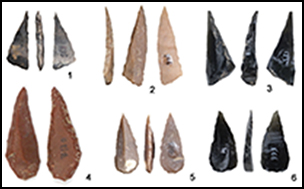Crossref Citations
This article has been cited by the following publications. This list is generated based on data provided by
Crossref.
Çilingiroğlu, Çiler
Kaczanowska, Malgorzata
Kozłowski, Janusz K.
Dinçer, Berkay
Çakırlar, Canan
and
Turan, Didem
2020.
Between Anatolia and the Aegean: Epipalaeolithic and Mesolithic Foragers of the Karaburun Peninsula.
Journal of Field Archaeology,
Vol. 45,
Issue. 7,
p.
479.
Maloney, Tim Ryan
and
Street, Mervyn
2020.
Hot debate: Identifying heat treatment in Australian archaeology using science and modern indigenous knowledge.
Quaternary Science Reviews,
Vol. 241,
Issue. ,
p.
106431.
Tatsumi, Yuki
2020.
A Neolithic sedentary hunter–gatherer settlement with densely arranged buildings: results of geophysical prospection at Hasankeyf Höyük in south‐eastern Anatolia.
Archaeological Prospection,
Vol. 27,
Issue. 4,
p.
329.
Özkaya, Vecihi
and
Sıddıq, Abu Bakar
2020.
A heart-shaped bone artifact from Körtiktepe.
Antropoloji,
p.
44.
Kodaş, Ergül
2021.
Fouille de la partie est de Boncuklu Tarla : nouvelles données sur la fin du PPNA dans la vallée du haut Tigre.
Syria,
Vol. 98,
Issue. ,
p.
241.
Carter, Tristan
Moir, Rose
Wong, Todd
Campeau, Kathryn
Miyake, Yutaka
and
Maeda, Osamu
2021.
Hunter-fisher-gatherer river transportation: Insights from sourcing the obsidian of Hasankeyf Höyük, a Pre-Pottery Neolithic A village on the Upper Tigris (SE Turkey).
Quaternary International,
Vol. 574,
Issue. ,
p.
27.
Carter, Tristan
Contreras, Daniel A.
Campeau, Kathryn
and
Makarewicz, Cheryl A.
2023.
Cappadocian obsidian exchange networks in the Pre-Pottery Neolithic A: a Southern Levantine perspective from el-Hemmeh (Jordan).
Journal of Archaeological Science: Reports,
Vol. 48,
Issue. ,
p.
103857.
Kodaş, Ergül
2023.
The younger Dryas layer at Boncuklu Tarla and the beginning of village life in the upper Tigris Basin.
Archaeological Research in Asia,
Vol. 35,
Issue. ,
p.
100460.
Zeder, Melinda A.
and
Lemoine, Ximena
2023.
A Journey Begins with a Single Step: How Early Holocene Humans and Wild Boar (Sus scrofa) Embarked on the Pathway to Domestication in the Eastern Fertile Crescent.
Journal of Archaeological Method and Theory,
Vol. 30,
Issue. 3,
p.
895.
Özkaya, Vecihi
and
Sıddıq, Abu Bakar
2024.
A heart-shaped bone artifact from Körtiktepe.
Antropoloji,
p.
74.
Goring-Morris, A. Nigel
Munro, Natalie D.
Özbaşaran, Mihriban
Kayacan, Nurcan
Ergun, Müge
Uzdurum, Melis
Yelözer, Sera
Kalkan, Fatma
and
Duru, Güneş
2024.
Variation in the development of Neolithic societies atop the Central Anatolian Plateau: recent results from Balıklı.
Antiquity,
Vol. 98,
Issue. 401,
p.
1163.
Shemer, Maayan
Brailovsky-Rokser, Lena
and
Birkenfeld, Michal
2024.
The Early PPNB of Amqa (Upper Galilee, Israel) from a Regional Perspective.
Paléorient,
Vol. 49-2,
Issue. ,
p.
43.
Zeder, Melinda A.
2024.
Out of the Shadows: Reestablishing the Eastern Fertile Crescent as a Center of Agricultural Origins: Part 2.
Journal of Archaeological Research,
Ishida, Atsumi
Dubreuil, Laure
Hisada, Ken-ichiro
and
Miyake, Yutaka
2025.
Neither wheat, nor barley: An appraisal of the functional variability of the grinding and pounding stones from Hasankeyf Höyük, a Neolithic hunter-fisher-gatherer site on the upper Tigris.
Journal of Archaeological Science: Reports,
Vol. 62,
Issue. ,
p.
104994.
Fuller, Dorian Q
and
Lucas, Leilani
2025.
Contrasting pathways to domestication and agriculture around Southwest Asia.
Archaeological and Anthropological Sciences,
Vol. 17,
Issue. 4,
